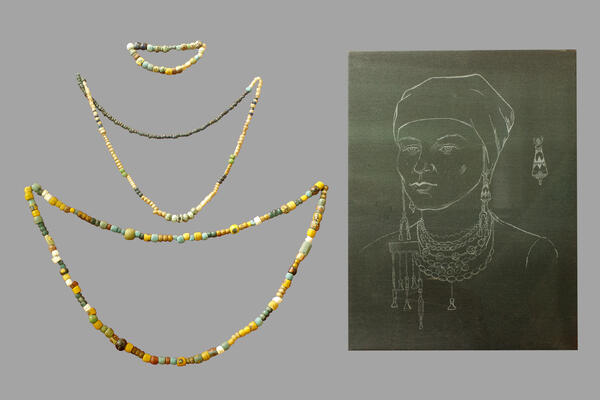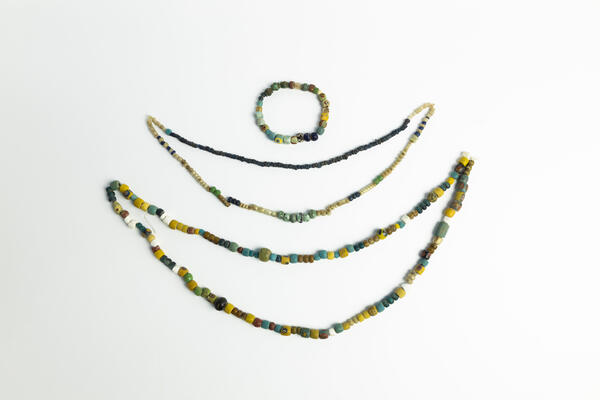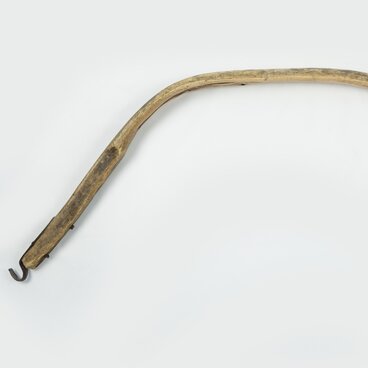The culture and way of life of the ancestors of the northern Udmurts during the Middle Ages are echoed in the archaeological artifacts found in the Cheptsa River basin. There are more than two hundred historical monuments: hillforts, settlements and burial grounds, where objects of worship, tools, utensils, personal belongings and jewelry are unearthed. The most studied monuments of this area are the settlements of Idnakar, Dondykar, Vesyakar and Guryakar, which, according to Udmurt legend, were founded by the ancient heroes Idna, Dondy, Vesya and Gurya.
The Vesyakar settlement is located near the village of Vesyakar in the Glazovsky District of the Udmurt Republic. It occupies an area of 60 acres and has a series of fortifications. Archaeologists found there a cultural layer of 1 to 1.8 meters in depth, which contains artifacts that reveal the material and spiritual culture of medieval Udmurts. The Glazov Museum of Local Lore presents a string of beads found at the Vesyakar settlement by an archaeological expedition in 1957–1958. This simple women’s jewelry helps to study the trade and economic ties of medieval Udmurts.
In the Early Middle Ages, the local population actively traded with the eastern regions. They exchanged furs, non-ferrous metals, coins, jewelry, and beads. Necklaces with glass beads were brought to the banks of the Cheptsa River by Bulgarian merchants from the Mediterranean countries. A thousand years ago, such beads were an expensive decoration and were highly valued in society.
In its modern meaning, the Russian word “boosy” — bead necklace — appeared in the Russian language in the 17th century. Previously, the word “ozherelye” (“necklace”) was used — something that is worn around the “zherelo” (neck). Medieval necklaces contained 600 multicolored beads made of glass and gems. For one bead, local hunters gave two squirrel pelts, as back then they used fur money.
Glass beads for necklaces were produced in Syria and Egypt, but by the 13th century they had been completely replaced by beads made in Rus. Often they were beads of different colors and shapes with a hole, or an eye, in the middle. To make the eye, small glass sticks were through the sides of red-hot beads of yellow, red and blue colors. Such beads were part of the capital of a woman and her family, so jewelry production developed rapidly in Rus.
The Vesyakar settlement is located near the village of Vesyakar in the Glazovsky District of the Udmurt Republic. It occupies an area of 60 acres and has a series of fortifications. Archaeologists found there a cultural layer of 1 to 1.8 meters in depth, which contains artifacts that reveal the material and spiritual culture of medieval Udmurts. The Glazov Museum of Local Lore presents a string of beads found at the Vesyakar settlement by an archaeological expedition in 1957–1958. This simple women’s jewelry helps to study the trade and economic ties of medieval Udmurts.
In the Early Middle Ages, the local population actively traded with the eastern regions. They exchanged furs, non-ferrous metals, coins, jewelry, and beads. Necklaces with glass beads were brought to the banks of the Cheptsa River by Bulgarian merchants from the Mediterranean countries. A thousand years ago, such beads were an expensive decoration and were highly valued in society.
In its modern meaning, the Russian word “boosy” — bead necklace — appeared in the Russian language in the 17th century. Previously, the word “ozherelye” (“necklace”) was used — something that is worn around the “zherelo” (neck). Medieval necklaces contained 600 multicolored beads made of glass and gems. For one bead, local hunters gave two squirrel pelts, as back then they used fur money.
Glass beads for necklaces were produced in Syria and Egypt, but by the 13th century they had been completely replaced by beads made in Rus. Often they were beads of different colors and shapes with a hole, or an eye, in the middle. To make the eye, small glass sticks were through the sides of red-hot beads of yellow, red and blue colors. Such beads were part of the capital of a woman and her family, so jewelry production developed rapidly in Rus.




